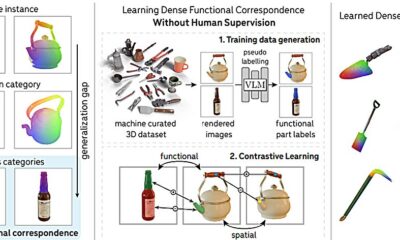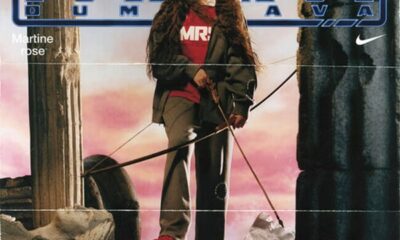Tech
How a 2020 Rolex Collection Changed the Face of Watch Design

As the company that either invented or popularized the dive watch, the GMT watch, the first water-resistant watch, the first automatic watches, and much more besides, you could hardly downplay Rolex’s influence on watchmaking history. But while its iconic sports watches, like the Submariner, Daytona and GMT-Master are endlessly imitated, Rolex is not seen as a trendsetter, preferring to ignore passing horological fashions. It does its own thing, iterating carefully and minimally on its age-old templates.
Five years ago, however, Rolex introduced a collection so avant-garde that is still influencing creative decisions across the entire watch industry, and it did so in one of its least-heralded models: the Oyster Perpetual. The idea was so simple that we’ve barely noticed it become the industry norm: Instead of slowly rolling out new dial colours one at a time over a period of years—which was standard watch world behavior until that point—Rolex launched a whole set of colored dials in a complementary palette all at once.
They were bright, bold and almost childlike in their purity: coral red, green, turquoise, pink and yellow. Rolex-watchers immediately hailed them as a tribute to the so-called Stella dial Day-Date watches of the late 1970s and 1980s—equally bright and unexpected, and evocative of a louche, sybaritic age. But there was something more basic, more essential and, at least theoretically, more attainable about the Oyster Perpetual collection.
It sparked imitators left, right and center—and still does. At last week’s Geneva Watch Days 2025, Zenith’s collaboration with Swiss furniture-maker USM would qualify as a textbook example: a full set of bold, block-colour dials in otherwise traditional stainless steel sports watches.
Earlier this year, Oris’s Big Crown Pointer Date hit a similar note. In 2023, arch-rival Omega debuted a collection of Seamaster Aqua Terra models with similar hues to Rolex’s opening salvo; other mid-level brands including Breitling and TAG Heuer have all created multi-colored families of stainless steel, time-only round watches in a similar mold.
Tech
OnlyFans Goes to Business School

OnlyFans has tapped the founder of a lingerie company and former nude model to launch business classes on the platform.
Rachael McCrary, a longtime lingerie designer and founder of the company Spice Rack, is launching four videos on OnlyFans Wednesday. The videos are quite different from the usual OnlyFans fare. They’ll focus on pitching investors, building a brand, and navigating being an entrepreneur as a woman, McCrary tells WIRED. More videos will follow. She’s also creating a Spice Rack x OnlyFans clothing line that will launch on the site later this year.
The move is OnlyFans’ first foray into making content focused solely on building a business. It’s part of the platform’s continued push into safe-for-work content that’s meant to complement the adult content it’s known for.
“OnlyFans is a community of over 4 million creator businesses, so it makes sense that we are the perfect platform to share tips on entrepreneurship,” Keily Blair, CEO of OnlyFans, tells WIRED in a statement. “As we’ve seen in other genres like comedy and sport, it takes just one creator to recognize the opportunity and others will follow suit.”
McCrary, 48, said she met Blair at the tech conference Summit Baja last November, when they came up with the idea.
As a former SuicideGirl—a community of alt pin-up girls founded in the early 2000s—she says she felt stigmatized by her past when working in corporate fashion. At one of her jobs, she says her colleagues looked at her SuicideGirls photos while she was at work.
“I just wanted to start crying,” she says.
Then she decided to launch her own businesses, but “pitching underwear to tech VCs, I already felt like I had to prove myself more,” McCrary says. According to Inc., only 1 percent of VC-funded companies were wholly led by women in 2024. Spice Rack, which McCrary says is backed by Sequoia Partners China and Mucker Capital, is among them.
“Being naked on the internet and raising venture capital from the largest funds in the world is a very rare Venn diagram,” McCrary says, adding that OnlyFans was already looking to expand into more non-adult content. “We decided to do a masterclass format of business classes.” The first two classes will be free, while the others will require a subscription to McCrary’s page.
Over the years, McCrary says, she’s been approached by many young women, including sex workers, seeking advice on how to start their own businesses or pivot away from adult content. After she revealed her past as a SuicideGirl on a panel in 2022, she says an adult content creator came up to her and said, “I didn’t know that you were naked on the internet, and that makes me feel like I can have a career after this.”
Tech
Australian police design AI tool to decipher predators’ Gen Z slang

Australian police are working on an AI prototype that will help them decipher Gen Z slang and emoji-laden messages written by online predators, a top official said Wednesday.
Australian Federal Police Commissioner Krissy Barrett said social media had become a breeding ground for bullying, sexual exploitation and radicalization.
Police were working with software giant Microsoft to develop a tool that would unravel sinister messages hidden by seemingly innocuous emojis and slang, she said.
“Clever AFP members, with Microsoft, are developing a prototype AI tool that will interpret emojis and Gen Z-and-Alpha slang in encrypted communications.
“This prototype aims to make it quicker for our teams to save children from harm much earlier.”
Barrett also warned about the rise of so-called “crimefluencers”—online predators who used their social media savvy to target young and vulnerable users.
“They are crimefluencers, and they are motivated by anarchy and hurting others, with most of their victims pre-teen or teenage girls,” she said.
Australia will from December 10 force social media platforms such as Facebook, Instagram and TikTok to remove users under the age of 16.
There is keen interest in whether Australia’s sweeping restrictions can work, as regulators around the globe wrestle with the dangers of social media.
© 2025 AFP
Citation:
Australian police design AI tool to decipher predators’ Gen Z slang (2025, October 29)
retrieved 29 October 2025
from https://techxplore.com/news/2025-10-australian-police-ai-tool-decipher.html
This document is subject to copyright. Apart from any fair dealing for the purpose of private study or research, no
part may be reproduced without the written permission. The content is provided for information purposes only.
Tech
Vintage rail freight system showcases 50-year-old innovation | Computer Weekly

Fifty years ago, three IBM System 370 mainframes powered a pioneering scheduling system run by the UK’s national rail operator, British Rail. Called Total Operations Processing System (Tops), when it went live on 27 October 1975, the system revolutionised the control of all rail freight operations across Britain online and in real time.
It used British Rail’s own telephone network and, along with a pair of IBM System 370/168 and a System 370/158 mainframe, Ventek minicomputers with built-in punchcard machines were installed at every area freight terminal.
In an article published in its 30 October 1973 magazine issue, Computer Weekly described the system as: “One of the most extensive and comprehensive freight management systems in the world.”
Commenting on the 50th anniversary, Jonathan Aylen, a Tops specialist at the University of Manchester, said: “Tops covered the whole of the UK, every freight wagon and loco, every train movement and every cargo all monitored by a central computer system at Marylebone in London. The control headquarters was described as ‘space age’ for its day.”
Marylebone housed 32 IBM 3330/33301 Control Data Drives, providing a whooping 3.2Mbytes of storage.
The Computer Weekly article reported that Tops divided the country into 152 Tops Responsibility Areas (TRAs), each with a Ventek 9200 minicomputer system. Describing how the system operated, the Computer Weekly article noted: “The basis for Tops in the field is the punch card, one card for one wagon. As traffic is moved from one TRA to another, new cards showing the changed status are produced. The receiving officer at an Area Freight Centre (AFC) checks the cards against wagons and feeds this information into the system to update the database.”
As Aylen noted in The convergence of computing and telecommunications: Cold War to coal trains paper he co-authored in 2024, the network British Rail used was state of the art for the time, using co-axial cables for the main trunk line links, with 4Mhz analogue transmission (equivalent to 960 telephone channels). Local links were carried on 12 channel frequency division multiplex systems on balanced copper cable pairs. These gave a high-quality speech path of 4Khz channels to every major station, office complex and freight yard in the country.
But it also stretched overseas. Computer Weekly reported that Ventek minicomputers were also deployed in France at Dunkirk, and there was a Telex link in Zeebruggee, Belgium. Data from the freight centres was fed into the Marylebone computer room via a data network which spanned 400km.

“Today we take computer control of business operations for granted. But fifty years ago, it was a revolution to know what was happening right across the business in real time, especially a system which saw up to 3,000 freight train movements daily,” Aylen said.
Tops highlighted the actual demand for wagons, which meant that many were surplus and sold for scrap, therefore reducing maintenance costs and helping to pay for the overall system.
Bob Gwynne, rail expert, said: “This had one major unforeseen consequence: one scrapyard in South Wales concentrated on quick and easy wagon disposal. Difficult steam locos were set aside for later. This breathing space led to 213 steam locomotives being acquired for preservation, approximately two-thirds of the total steam locomotives preserved today.
“So, an unintended effect of Tops was the birth of the heritage railways as a nationwide tourism product, rather than the handful of locations that pre-date 1975.”

Many thanks to The National Museum of Computing (TNMOC) for providing scans of the original Computer Weekly article. The full Computer Weekly archive dating back to September 1966 is held at TNMOC.
-

 Fashion1 week ago
Fashion1 week agoChinese woman charged over gold theft at Paris Natural History Museum
-

 Entertainment1 week ago
Entertainment1 week agoJohn Grisham unveils his first-ever mystery, “The Widow”
-

 Tech1 week ago
Tech1 week agoThis Smart Warming Mug Is Marked Down by $60
-

 Tech1 week ago
Tech1 week agoEaster Island’s Moai Statues May Have Walked to Where They Now Stand
-

 Fashion1 week ago
Fashion1 week agoThe North Face and Cecilie Bahnsen launch second collaboration
-

 Tech1 week ago
Tech1 week agoOpenAI has slipped shopping into ChatGPT users’ chats—here’s why that matters
-

 Tech1 week ago
Tech1 week agoAI model could boost robot intelligence via object recognition
-

 Politics4 days ago
Politics4 days agoTrump slams ‘dirty’ Canada despite withdrawal of Reagan ad

















